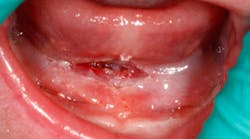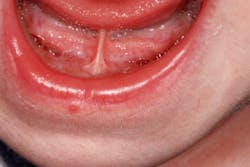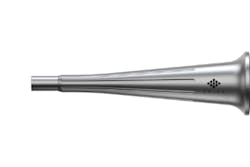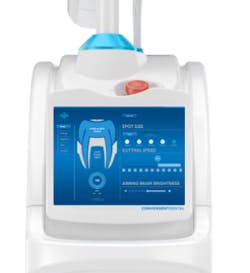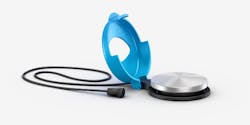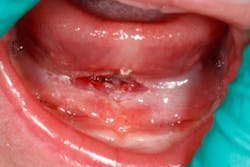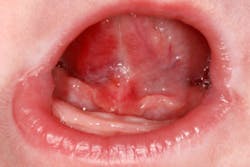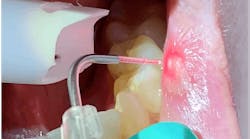Surgery on a newborn? CO(2) laser makes in-office lingual frenectomy easy for general dentist to perform
In this case study, Joshua P. Weintraub, DDS, describes the lingual frenectomy procedure he did in-office to reverse an extensive tongue-tie on an eight-day-old infant. He explains how his CO2 laser allowed him to operate less invasively with minimal bleeding, no sutures, minimal postoperative pain, and faster healing.
Editor's note: This article first appeared in DE's Breakthrough Clinical with Stacey Simmons, DDS. Find out more about it and subscribe here.
AS A GENERAL DENTIST, there are certain cases you would not dream of treating. Perhaps you are not equipped ... perhaps you were not trained ... perhaps the case should be referred out to a specialist ...
The following frenectomy procedure is a case that, years ago, I never would have thought I’d be performing in-office or, moreover, on an eight-day-old infant. It is incredibly moving to be able to provide such a valuable service for babies and to help moms enjoy those first days with their newborns.
Frenectomies can be released safely and efficiently using a CO2 laser with predictable and consistent tissue response, quick ablation, and immediate hemostasis. The laser's exceptionally precise cutting and clear, bloodless operating conditions make it an ideal choice for these common procedures that general dentists generally seem to shy away from.
Unlike other lasers, CO2 lasers gently vaporize tissue, offering a blood- and suture-free patient experience with minimal discomfort. From simple cavity preps to gingivectomies and frenectomies, I use my laser (Solea from Convergent Dental) for almost every procedure imaginable for most patients. Not only will your adult patients no longer dread coming to see you for scheduled procedures, but the laser is also a safe—if not safer—alternative for use on pediatric patients as well.
Case presentation
Though my laser can be used on all tissues—including tooth structure, soft tissue, and osseous tissue—this case is an example of how unintimidating an extremely sensitive case involving soft tissue can be for virtually any general dentist using a computer-driven 9.3 µm CO2 laser.
The patient, an eight-day-old infant referred by the lactation consultant, presented with an excessively tight lingual frenum—an issue in which patients are often referred to as tongue-tied. This was a Class I tie (figure 1). The baby was not able to extend the lip or lift the tongue, so subsequently there was significant difficulty with nursing that needed to be addressed and treated immediately. One common symptom in this case was that the mother was experiencing significant pain during nursing due to the infant's improper latching. Successful treatment was rapidly completed with my CO2 laser. The infant was able to nurse well, and the mother was able to have a more comfortable experience. In this case, and most others involving the laser, improvement is immediate.
Technique
No anesthetic (neither local nor injectable) was used to help avoid any risk of toxicity, aspiration, and/or gagging issues. To begin, the infant was swaddled and an assistant stabilized the infant in a position to maintain an open airway. A second assistant provided suction.
An instrument called a “grooved director”—a unique forked instrument that holds the frenum and lifts up the tongue—was used to assist with the laser treatment.
The Solea straight handpiece was used for this case (figure 2). Lasing began underneath the tongue, aimed toward the frenum. The floor of the mouth was avoided, due to the delicate nature of this area.
Figure 2: Solea straight handpiece
The entire procedure was completed with a single setting on the laser(figure 3), and cutting speedwas controlled with the variable-speed foot pedal (figure 4). When working with infants, it is important to avoid the use of air or water to decrease the risk of gagging or fluid aspiration.
Figure 3: The laser's user interface
Figure 4: The laser's variable-speed foot pedal
The time spent performing the laser surgery for this frenectomy was less than one minute (figure 5)!
Figure 5: Immediately post-op
Stretching exercises were prescribed for the patient to minimize reattachment of the frenum.
Benefits of the laser
Computer-driven lasers allow dentists to bring the variety of services they offer to another level, while providing the best dentistry possible for patients. While CO2 lasers are the gold standard for soft tissue, the 9.3 µm CO2 laser allows dentists to ablate all tissues without having to adjust complicated settings. It’s as simple as turning on the laser, directing the beam at the desired tissue, and stepping on the variable-speed foot pedal. This one-setting-fits-all approach has significantly increased efficiency in my office and, moreover, has given me the confidence I need to perform procedures I likely would have referred out in the past. With my laser, I can now do so many procedures less invasively, with minimal postoperative pain and faster healing than with traditional techniques.
Case outcome
The Solea laser enabled the delicate frenectomy procedure involving the eight-day-old infant to be completed quickly, with minimal bleeding, and extremely fast healing. With traditional instruments (i.e., a scalpel), there would have been more bleeding and an extended healing process. The results of this procedure were substantial: the baby nursed immediately post-op, and mom noticed an improvement right away.
She said, “This is the first time I’ve nursed and it hasn’t hurt!”
Those words were the greatest reward, knowing how much I was able to help in this case. The infant healed extremely well, there was no frenum reattachment, and the baby was able to successfully nurse. I am absolutely thrilled to be able to provide this important service to my patients right in my own office (figure 6).
Figure 6: 10 days post-op
Editor's note: This article first appeared in DE's Breakthrough Clinical with Stacey Simmons, DDS. Find out more about it and subscribe here.
